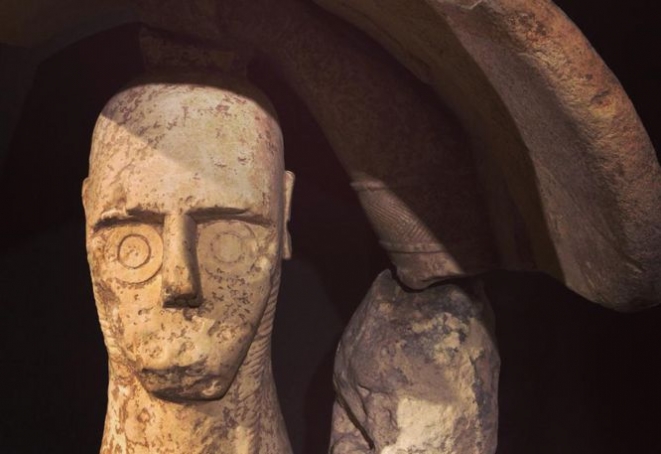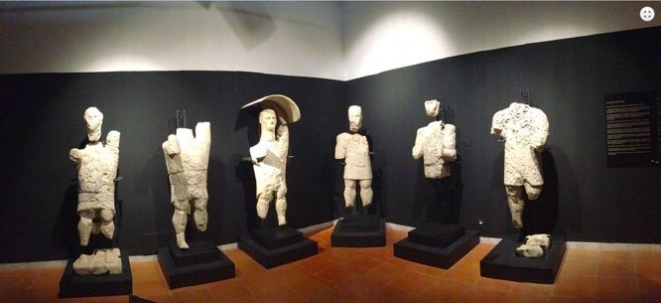The archaeological civic museum "Giovanni Marongiu"
A cultural heritage with a nuragic and Sardinian identity
Archaeology (from the Greek language ἀρχαῖος "old", λόγος "study" ), formerly indicated as "science that was auxiliary of the history", allows to study the most remote civilizations and their relationship with the present, through the collection of documents and the analysis of human and biological relics, as well as artifacts and architectures, using, as the first big tool, the stratigraphic digging out. Sardinia offers a wide object of study with its archaeological sites.
The rural aggregate in Cabras hosts the civic museum dedicated to the local administrative clerk Marongiu, Minister for the extraordinary interventions in the South Italy in the last Administration Andreotti. The district, situated in the area of the Campidano in Oristano along the left bank of the basin Mari Pontis, is called Masone de Capras since the end of the Eleventh Century, time frame to which the first establishments into the current residential area come from, after the depopulation of Tharros, because of the raids by the African corsairs.
All along a place symbol of culture, Cabras, thanks to the civic museum, is a promoter of a rich exposition of archaeological evidences, marks of the local territory since the Prehistory to the Middle Ages and guarantee of the peninsular history of Sinis.

The museum path is innovative, because it is characterized by various didactic panels used for gaining the visitor’s attention, through the educational tale of the specific events for each expositive section. One of these is directed to the materials that come from the site Cuccuru is Arrius, hill elevation in the South of the basin of Cabras. Establishment for man since the Middle Neolithic, with a culture Bonuighinu in the Fifth millennium Before Christ, it is a necropolis of individual tombs with an artificial small cave dug in an arenaceous counter and with an entrance with a little well.
It is particular the funeral rite that considered the location of the dead on the left side with the face oriented towards the rising sun and in the entrance of the cell furnished with bowls, fictiles, ceramic vases, bone tools and stone tools, shell necklaces as ornamentation.
It is symbolic the feminine stony statue, naturalist symbol of the whole figure of woman with curved and curvy shapes. The human establishment carries on towards the Higher Neolithic, towards that recent and towards the Neolithic Age, with the culture Ciriaco (the Fifth-Fourth millennium Before Christ), Ozieri (the Fourth millennium Before Christ) and South of Ozieri (the Third millennium Before Christ).
Since those prehistoric stages, when the villages were composed by huts that were covered by vegetable materials, a multiplicity of ceramics with various shapes, sizes and decorations came. It is important the temple with the well of the nuragic communities of the final Bronze Age (1200-900 Before Christ) when there was the rite of the spring water, symbol of fertility and life. The monetary and ceramic evidences and those for ornamentation of the dead belonged to the Imperial Age.
The section dedicated to Tharros, a Phoenician town, (the Eighth-Seventh century Before Christ) consists of a representation of the archaeological surveys about the metallurgic district of the Punic Age, whose activity is proved by the discovery of iron dross and materials of the housing context; and to the Tofet, typical outdoor Phoenician-Punic sanctuary surrounded by the temenos (delimiting wall) where there were the ceramic urns containing relics of children and animals, to which sandstone steles were associated. They are exposed in the central hall of the Museum and they are representative of the sacred temples where the divinity does not have the illustrated shape (not illustrated shape).
Inaugurated on 7 june 2008 the hall dedicated to the wreck of Mal di Ventre Island (Isula de Malu Entu), underwater discovering of 1989 whose importance is given by the load of massae plumbae (lead ingots) previously reached only with limited quantity. Two collections are those that were conserved into the Museum in Cabras: that of Paulis composed by metal things of nuragic handcrafted production; and that of Sulis with almost 60 evidences of that epoch since the Prehistory to the Late Ancient Times.

Sa Osa is the nuragic village to which the Museum dedicates two showcases, in particular, to the digging out guarantee of the human establishments that prevailed in the Nuragic Age so that in one of the typical wells of the Bronze Stage seeds of grapes and of fig have been discovered – the most remote kind of marks of vine cultivation in Sardinia.
It is unforgettable for the history of the civic museum in Cabras the date of 21 March 2015, a day when the hall "From the digging out to the Museum", the permanent location of the Giants of Mont’e Prama, was inaugurated by the President of the Chamber of Deputies, Laura Boldrini and the Regional Assessor of Culture, Claudia Finno. So, they decided for their preservation in the museum, begun with a first stage on 22 March 2014 and pointed to the unification of the location of the statue complex. Discovered casually in 1974 by the farmer Sisinnio Poddi, while he tilled in a field of the area Mont'e Prama in Cabras, the Kolossoi – name confered by the archaeologist Giovanni Lilliu – are nuragic sculptures sculpted with a local sandstone, high more than two meters, representative of warriors with a shield, archers, boxers and models of nuraghes.
Among the evidences discovered in the digging out, in particular through the second campaign lead between 1977 and 1979 in the necropolis of Mont'e Prama, the betiles are included (from Hebrew language Beith-El, "House of God"), stones with the sacred function of the house of the divinity or of the identification with the divinity herself. Sculpted in the sandstone, they belong to the type "Oragiana", with a conical shape with quandrangular hollows under the peak. Twenty statues not complete, identified through a restoration of the accumulation of 5178 fragments of masculine statues and sandstone sculpted elements, come between the Eleventh and the Tenth Century Before Christ, according to a hypothesis through which they are collocating among the most ancient statues in the Mediterranean basin, because they were previous to the Kouroi, sculptures of the ancient Greece of the archaic period.
It is extraordinary the expositive innovation of the Museum consisting of the multimedia system of the team of Visual Computing of the CRS4 "Center of research, development and upper studies in Sardinia ". This digital machinery, thanks to a totem of touch screens situated in the main expositive hall, allows to visitors the complete and detailed visualization, with the natural size of Giants and of nuraghes. An archaeological treasure where the statue evidences are presented in a dark space with an oblique light and spread in the perimetral length. The facades of the new wing were interpreted again according to the technique of Sand-casting by Costantino Nivola.
Open every day, except on Mondays, the civic museum in Cabras, near which there are the ruins of Tharros, offers a careful exhibition of Sardinian historic and archaeological heritage, revealing itself, for each visitor, a cultural improvement with a well-known resource.